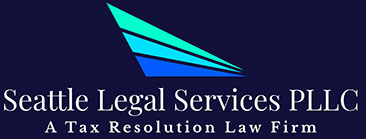IRS Forms 1094/1095-C | Who Has to File & What if You Don’t?

Forms 1094-C and 1095-C are used by companies to report necessary information about health insurance and coverage to the IRS. The forms show which employees have health coverage through the company and which employees have been offered health insurance. Failure to file or incorrectly filing forms 1094/1095-C can result in penalties.
Here’s everything you need to know about forms 1094/1095-C. Already facing a penalty? Want help completing these forms? Then, contact us at Seattle Legal Services today.
What is Form 1095-C?
Employers with at least 50 full-time workers are required by the Affordable Care Act (ACA) to provide health insurance to their employees. Then, each year, these employers must send out a statement (Form 1095-C) to all employees who are eligible for coverage.
The form includes details about the months the coverage was offered, the cost of the lowest-cost monthly premium, and the employee’s share of the monthly premium. It also indicates whether the coverage provided meets the minimum essential coverage and affordability requirements outlined by the ACA.
What is Form 1094-C?
Unlike Form 1095-C, which provides detailed information about each employee’s health coverage, Form 1094-C serves as a summary or cover sheet for multiple Form 1095-C submissions.
Employers use Form 1094-C to report combined information to the IRS, such as the total number of full-time employees and the number of employees offered health coverage. It also includes information about the employer’s contact person and whether the employer qualifies for certain transition relief.
What is the Affordable Care Act?
The Affordable Care Act (ACA) is a comprehensive healthcare reform law passed in the United States in March 2010. The primary goals of the ACA are to increase the quality and affordability of health insurance, expand Medicaid eligibility, and decrease the overall number of uninsured individuals in the country.
Here’s how Forms 1094/1095-C ties into the ACA.
Individual Coverage Information
Form 1095-C provides detailed information about the health coverage offered by the employer to each individual employee. It includes details such as the months for which coverage was available, the cost of the lowest-cost monthly premium, and the employee’s share of the monthly premium.
Minimum Essential Coverage (MEC) and Affordability
Form 1095-C helps determine whether the coverage provided meets the ACA’s requirements for minimum essential coverage (MEC) and affordability. This is crucial for ALEs to avoid potential penalties under the employer mandate.
Employee Statements
Employers are required to furnish copies of Form 1095-C to their employees. Employees use this information when filing their individual income tax returns to report compliance with the ACA’s individual mandate and to determine their eligibility for premium tax credits.
Overall, Forms 1094/1095-C plays a central role in the ACA’s efforts to ensure that applicable large employers (ALEs) provide adequate and affordable health insurance coverage to their employees. The information reported on this form helps both the IRS and individual taxpayers monitor and enforce the ACA’s provisions related to employer-sponsored health coverage.
Who Needs to File Forms 1094/1095-C?
ALE Members are required to file Forms 1094-C and Form 1095-C for all full-time employees during the calendar year. An ALE Member is an Applicable Large Employer or member of an Aggregated ALE Group, whichever applies. An Applicable Large Employer typically employs 50 or more full-time employees (including full-time equivalents) in the previous year.
You may also need to file forms 1094/1095-C if you’re part of an Aggregated ALE Group. An Aggregated ALE Group is a collection of companies or employers regarded as a single entity by the IRS. This can occur when one firm owns another, or when multiple companies are owned by the same person.
How to Complete Form 1094-C
Here’s a brief breakdown of each section in Form 1094-C.
Part I
The first section of Form 1094-C includes the employer’s name, employer identification number (if you don’t already have one, you can apply online), address, name, and contact information.
Part II
This section concerns the ALE Members’ information, and requires:
- The number of 1095-C forms filed by and/or on behalf of the ALE member
- Member of an aggregated ALE group
- Certification of Eligibility
- The signature, title, and date
The most complicated section of Form 1094-C is line 22, “Certifications of Eligibility.” It is also the most critical section to do right. This line indicates whether an employer may use the offer method or transition relief. You can tick one of the following boxes:
- Qualifying Offer Method. Select this box if you extended a qualifying offer to one or more full-time employees for the whole year they worked for you.
- The 98% Offer Method. Select this box if you offer affordable health care and give minimum value to at least 98% of the employees who you fill out Form 1095-C for.
Part III
This section asks whether your company provided basic essential coverage to at least 95% of full-time employees for the whole calendar year. If you have done so, select the “Yes” checkbox next to “All 12 Months”. However, if your company didn’t meet essential coverage during particular months, you must identify which months by checking “No” next to the month.
Part IV
If you answered “Yes” to line 21 (Is ALE Member a member of an aggregated ALE group?), you must complete this section. If you were part of an aggregated ALE group during any month of the year, you must include the group members’ names and EINs.
How to Complete Form 1095-C
Here’s an overview of each section in Form 1095-C.
Part I: Employee and ALE
Part I of the 1095-C consists of two sections that contain employee and employer information.
Employee Details: In this section, you must enter basic information about the employee:
- Line 1: Name of employee
- Line 2: Employee’s Social Security Number
- Lines 3 – 6: Employee’s address
ALE Details: In this section, you must include basic information about the Applicable Large Employer (ALE):
- Line 7: Name of employer
- Line 8: The Employer Identification Number (EIN)
- Lines 9 – 13: Employer’s address
Part II: Employer Offer of Coverage
This section concerns the health insurance coverage details:
- Line 14: The 1095-C code. There are 21 codes (1A-1U) – enter the one that applies to the type of coverage offered.
- Line 15: This line only applies if the 1095-C code is 1B, 1C, 1D, 1E, 1J, 1K, 1L, 1M, 1N, 1O, 1P, or 1Q. If this applies, enter the Employee Required Contribution.
- Line 16: Enter the code for Section 4980H Safe Harbour and Other Relief.
- Line 17: Enter the zip code used to determine the employee’s affordability.
Part III
You only need to complete this section if you provide employer-sponsored, self-insured health coverage, which includes an individual coverage HRA:
- Lines 18-30: Details of the individuals covered in the plan, and how long the health plan is covered for (either check 12 months if covered all year or check the applicable months).
When are Forms 1094/1095-C Due?
In the 2015 tax year, it became mandatory to send out 1095-C forms. Employers must submit the forms not only to eligible employees but also to the IRS. Employees should receive them by the end of January.
Employers normally have until the end of February to submit them to the IRS if filing on paper, or until the end of March if filing online. However, employers with 250 or more forms must submit them electronically. Those with fewer than 250 can file paper forms or electronically.
Form 1094-C is typically due to the IRS along with copies of Form 1095-C by the end of February (or March if filing electronically) following the tax year being reported. Specific deadlines may vary, so it’s essential to check the IRS instructions for the relevant tax year.
How Does the IRS Use Forms 1094/1095-C?
The primary purpose of Forms 1094-C and 1095-C is to assess whether ALEs are in compliance with the ACA’s employer mandate. In short, the information on these forms helps the IRS determine whether employers are offering adequate and affordable health insurance coverage to their full-time employees.
Penalties for Not Filing or Incorrectly Filing Forms 1094/1095-C
Failure to file Forms 1094-C and 1095-C or filing incomplete or inaccurate information can result in penalties for ALEs subject to the Affordable Care Act (ACA) reporting requirements. Here are some of the penalties you could face for failing to file forms 1094/1095-C.
Section 6721 Penalty
ALEs can face a penalty under Section 6721 of the Internal Revenue Code for failing to file correct and timely information returns (Forms 1095-C) with the IRS. The penalty amount is assessed per form and is subject to inflation adjustments. As of 2024, the Section 6721 penalty is $310 per form not filed or over 31 days late. If intentional disregard is involved, the penalty is $630 per form.
Section 6722 Penalty
ALEs may also face penalties under Section 6722 for failing to furnish correct and timely statements (copies of Forms 1095-C) to employees. Like the Section 6721 penalty, this penalty is assessed per form and is subject to inflation adjustments.
The IRS may waive penalties if an employer can show that the failure to file or furnish correct information was due to reasonable cause and not willful neglect. Employers must be able to demonstrate that they acted responsibly and took appropriate steps to comply with the reporting requirements.
What is Letter 5699?
Letter 5699, also known as “Missing Information Return Form 1094/1095-C,” is a letter delivered to companies that the IRS believes were an Applicable Large Employer (ALE) for a specific tax year but did not submit the annual ACA filings.
The IRS issues Letter 5699 to remind companies to complete their ACA filings for a certain tax year. In addition to allowing companies to complete their forms without penalty, it also allows employers to fix any inaccuracies in the 1094-C and 1095-C filings for the relevant tax year.
Who Receives Letter 5699?
The IRS issues Letter 5699 to employers who may have failed to meet ACA reporting requirements for the indicated tax year. The IRS determines probable noncompliance based on employers’ overall Form W-2 count for the same tax year.
What Do You Need to Do if You Receive Letter 5699?
Letter 5699 offers employers options for their filing situation for a given tax year. The letter asks if the employer:
- Filed the documents using a different EIN. If so, supply the name, EIN, and date of filing.
- Should have filed the forms but didn’t. In this case, the employer must either submit the delinquent filing with the response or provide an explanation as to when the returns will be submitted.
- Has an “other” reason for not filing.
A response to the IRS must be submitted within 30 days from the date on the letter.
When to Seek Help From a Tax Professional
If your organization has a complex workforce structure, including part-time, seasonal, or variable-hour employees, and offers various health benefit plans, a tax professional can help navigate the intricacies of reporting for different employee categories and plan offerings.
Additionally, If your organization has experienced changes in its workforce composition, such as mergers, acquisitions, or significant fluctuations in the number of employees, a tax professional can assist in accurately reflecting these changes on Forms 1094-C and 1095-C.
To Sum Up
If you have the equivalent of 50 full-time employees you may be required to file Forms 1094-C and 1095-C with the IRS each year. These documents are always filed simultaneously and assist the government in determining whether all employers who are required to provide healthcare coverage to their employees do so. Filing forms on time helps you avoid costly penalties and guarantees that employees receive the health coverage they require.
If you have received letter 5699, or have questions or concerns regarding your 1094/1095-C forms, contact Seattle Legal Services, PLLC online or over the phone at 206-536-3152 today.
